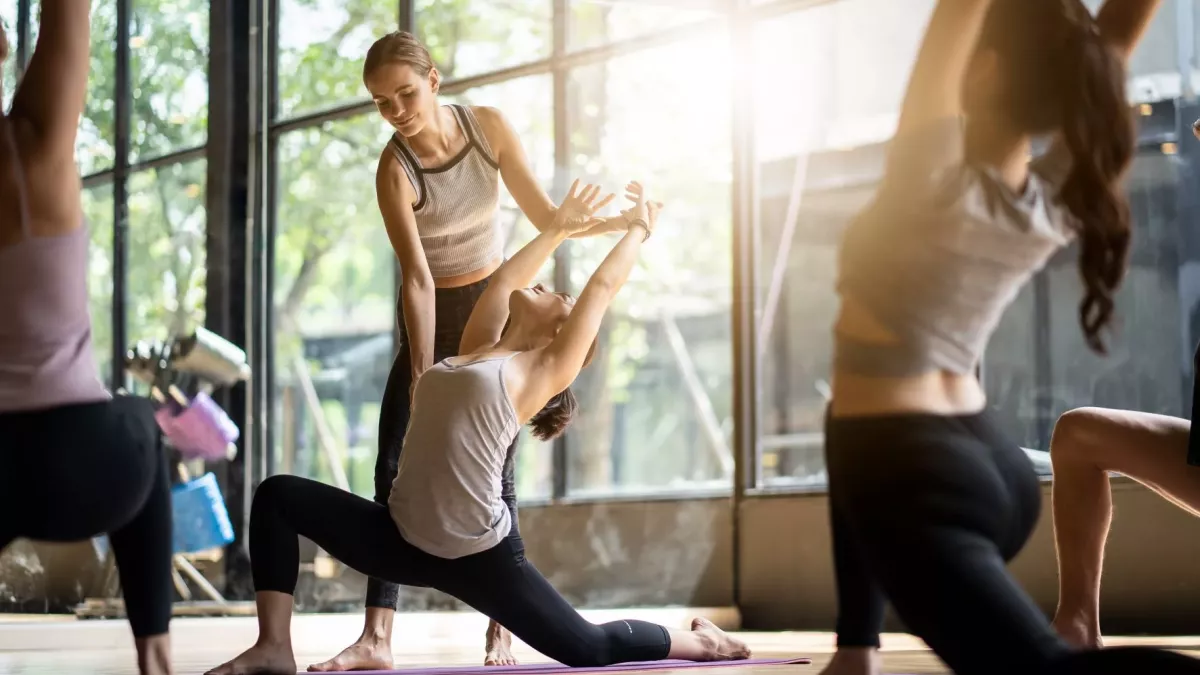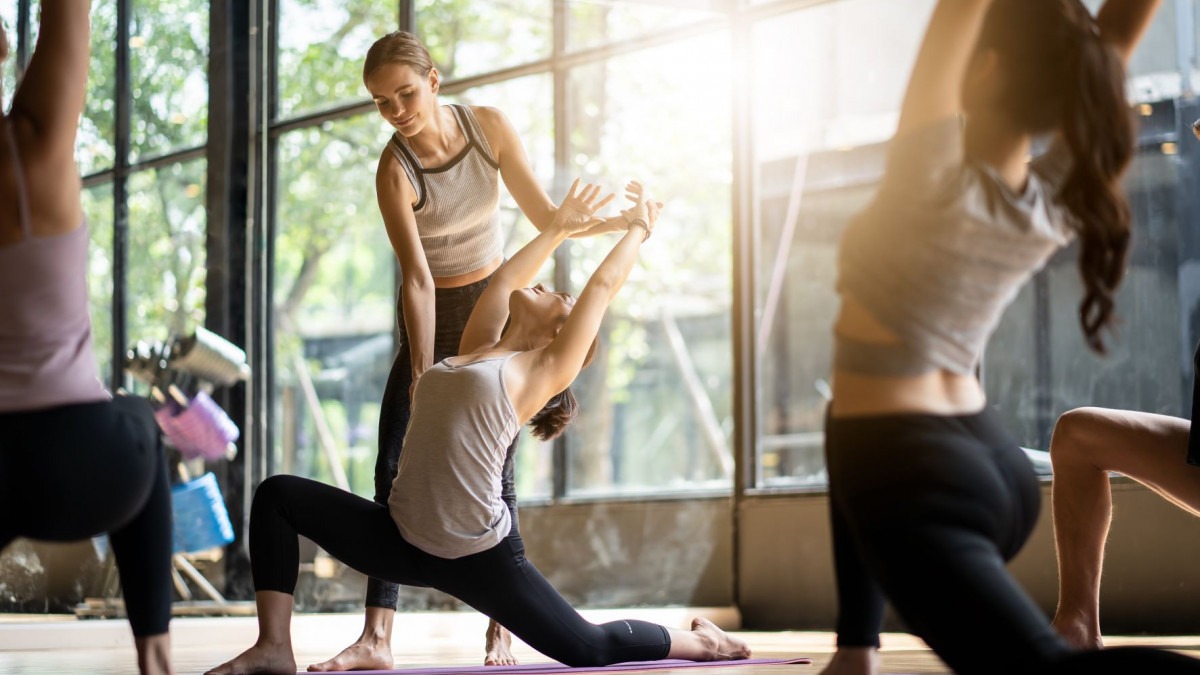Verified on 01/23/2023 by PasseportSanté

Yoga practitioners and Pilates practitioners are often contrasted: on the one hand, followers of the body-mind-breath triptych; on the other, enthusiasts of sheathing and postural exercises. What if these two popular disciplines merged? This is the principle of yoga-pilates, a hybrid practice that has brought together the best of both worlds for over 20 years.
Pilates vs. yoga, what’s the difference?
To understand what yoga-pilates is, you must first start by knowing what differentiates the two disciplines that constitute it.
Yoga
Yoga is an age-old practice from India that works the body and mind as a whole. Stretching, mobility and breathing exercises are common to the many currents that exist in yoga.
More dynamic styles also incorporate deep muscle strengthening, balancing postures and sometimes even acrobatics on the hands, shoulders and head. The spiritual aspect is also important in yoga, as well as lifestyle and self-connection through mediation. Some currents also incorporate songs and recitations
Pilates
Pilates is a method developed at the beginning of the 20th century by the German athlete Joseph Pilates. It is practiced on the ground, on a carpet with various accessories or with the help of a “Reformer”, an imposing machine the size of a bed, equipped with a sliding plate, pulleys and other tools. . It is an intense and gentle practice at the same time, without sudden movements or impact shocks. The abdominal, gluteal and back muscles are used in most exercises.
The goal of yoga-pilates is thus to strengthen and stretch the whole body, giving pride of place to postural exercises, sheathing and breathing.
The origins of yoga pilates
Australian Louise Solomon is unquestionably one of the pioneers of yoga-pilates. She developed her own method, called Yogalates, after discovering Pilates following injuries sustained during her yoga practice.
“Yogalates is the meeting point between East and West, a clever mix between the ancestral practice of yoga with Eastern origins and the dynamics of postural improvement of Pilates designed by and for Westerners”, describes- she.
The idea is to improve body awareness and alignment to help develop healthy movement habits to apply in daily life. It will be concretely a question of relearning to pick up an object on the ground or to get out of bed.
Yogalates classes aim to strengthen the subtle and structural core muscles through Pilates-based exercises, while incorporating the postures, philosophy and wisdom of yoga. Louise Solomon codified the practice and set up her Yogalates academy in the early 2000s in Australia.
At the same time, the American Jonathan Urla launched a similar movement with a small letter of difference all the same: the Yogilates. A major player in fitness in the United States, author and professor, he also developed his method which he describes as “the ideal way to optimize his sports exercises and his health”.
Its strength: being able to popularize and make complex and sometimes esoteric notions understood by as many people as possible. His reference work “Yogilates – Integrating Yoga and Pilates for Complete Fitness, Strength, and Flexibility” (Harper Collins) came out in 2002.
In addition to these two movements which are real trademarks, we now find, in France and abroad, more and more Pilates teachers who integrate yoga into their classes, and vice versa. Without putting a commercial label on this practice, it often appears under the name yoga-pilates or sometimes postural yoga. It can be given by teachers trained in both disciplines, but not exclusively.
A Pilates teacher in Paris for seven years and founder of the Le Club Pilates platform, Alice is one of the teachers inspired by the fusion of the two disciplines. “I add a lot of yoga postures to my Pilates classes. I may include concepts from many other disciplines such as self-massages, as long as it’s good for the body and it has meaning. The vast majority of my students have confidence and are guided, they are happy to broaden their perspectives,” she says.
Who can practice yoga-pilates?
Yoga-Pilates is for everyone, regardless of age and physical condition. The Pilates approach allows you to build muscle and find alignment in complete safety, even in the slightly more challenging postures of yoga.
Alice from Club Pilates warns however: “For purists who absolutely want to respect the codes and who are very specialized in their practice, it may be necessary to go their own way so as not to be disappointed by yoga-Pilates”.
For those ready to leave their comfort zone and their habits, it will simply be necessary to be open. In particular, pilates students should expect a little more spirituality, new ways of breathing and deeper stretching. Yoga students, on the other hand, can prepare for more anatomy and a greater focus on the center, the abdominals or even the back muscles.
What is the interest of practicing yoga-pilates?
The benefits of yoga-pilates are numerous:
- It increases strength and flexibility;
- It makes it possible to attenuate certain pains, in particular at the level of the lumbar ones thanks to the work of stability carried out;
- It improves general posture and posture;
- It decreases the stress and calms the mind, among other things through breathing;
- It promotes taking a step back, letting go and general well-being through meditation;
- Etc.
More concretely, Alice from Club Pilates explains that Pilates and yoga fit together particularly well: “With Pilates, we are sometimes a little limited in stretching postures. Thanks to yoga postures, we can go much further in complete safety and with respect for everyone’s physiology”.
She also explains that varying the approaches makes it possible to trigger clicks and therefore real progress in practitioners: “In Pilates, we use diaphragm breathing 90% of the time. So from time to time, at the end of a class , I add belly breathing like in yoga or ujjayi breathing to revive the energy. When you show new things, people understand better. If you just breathe through the diaphragm, they would end up saturating and miss out certain benefits of the practice.”
What Alice particularly likes about mixing yoga and Pilates is being able to break the rhythm of a class. For her, introducing yoga means learning to stay longer in a posture, it’s also having time to pause and breathe, and it’s connecting more to yourself with short and accessible meditations.
What does a yoga-pilates class look like?
A yoga-pilates class is very variable and depends above all on the teacher. Perhaps he is trained in a particular method (Yogalates, Yogilates, etc.) or does he himself incorporate postures from both practices?
In any case, expect to find key exercises from both practices such as the hundred in Pilates or the dog upside down in yoga. The latter is also a must in Alice’s classes at Club Pilates.
It also often includes the shoulder stand posture, a classic yoga, to add a bit of challenge in these classes, inversions being little or not present in yoga classes. “It’s out of the box, it’s true, but it’s a posture that makes the center work a lot and gives a beautiful sense of pride and joy to those who perform it. And in the end, that’s what matters. the most!” she concludes.
100% Readers found this article helpful And you?
Was this article helpful to you?
We would like to give thanks to the author of this write-up for this remarkable material
Yoga pilates: what is it?
Check out our social media accounts and also other related pageshttps://nimblespirit.com/related-pages/

